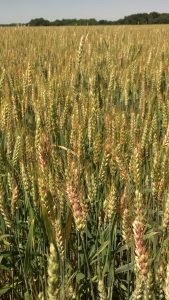Wheat Head Blight – Thoughts on Managing DON
The following is posted on behalf of Dr. Nathan Kleczewski, Field Crops Pathologist for Growmark
The following is posted on behalf of Dr. Nathan Kleczewski, Field Crops Pathologist for Growmark. This content is from the Field Crop Disease Hub webpage Dr. Kleczewski curated.
It is a little early to be discussing Fusarium head blight (FHB) , but it is something that always seems to come up in conversation. Currently our wheat has yet to to hit jointing, and it will be a while before we are at the flowering stage. It is at the flowering stage when we start to worry about FHB and the toxin the fungus the causative pathogen can produce, deoxynivalenol (DON-vomitoxin). Regardless, below are some general things to consider as the season continues and we enter the the flowering stage with our wheat.
One of the things I emphasize when discussing FHB is that it is beneficial to view the issue as DON management, not FHB management. Why do I say this? Fusarium can still infect and cause elevated levels of DON without causing visible symptoms such as bleaching or the production of chalky lightweight kernels. These kernels appear healthy in every way, except DON may be present at higher than acceptable levels. Tombstones can be economically reduced by increasing fan speed at harvest, and mills can further separate and clean infected grains using screening, optical sorters, and other methods. However, combines and mills cannot separate healthy looking grains with elevated DON from healthy grains without DON. It is the hidden DON that can be problematic, not only to the producer, but the mills and grain marketers, which may ultimately impact overall grain value. When you make the decision to grow wheat, DON should be on your mind.

There are several management practices that can be helpful when managing DON. First, select a moderately resistant wheat variety. There are many more moderately resistant varieties available for growers than in the past, and most produce excellent yields, even in the absence of FHB. Resistance is not complete, but varieties with moderate resistance to FHB on average, reduce DON 50% more than susceptible varieties and 20% more than moderately susceptible varieties. Recommended varieties for DON management can be found here. Remember that for the Illinois trials, varieties with LOWER ratings have BETTER DON resistance.
Second, a fungicide labeled for FHB can be applied to further reduce DON. Currently, our recommended fungicides include Caramba and Prosaro, which reduce DON by 45-42% over untreated checks, respectively. Applications can be made from the start of flowering (when 50% of main tillers have started to flower) through 5-6 days after the start of flowering without a loss in efficacy. Applications should be made using at least 10 GPA if by ground rig and 5 GPA if by air. Nozzles should be oriented to target the head. The Fusarium head blight prediction center can help you determine if a spray is required. If you have yet to enroll in alerts, make sure to do so soon. Lastly, avoid applying products with QoI (FRAC group 11) active ingredients to the head, as these have been demonstrated in replicated field trials to increase DON compared to untreated checks.
Third, tillage or planting wheat behind soybean may reduce local inoculum. Although we know that a significant portion of FHB spores enter the atmosphere and are deposited at night, a portion may still spread from local residue to flowering wheat heads. Tillage can bury this residue, minimizing the amount of local sporulation. The FHB pathogen grows much less efficiently on soybean residue than corn residue. Local inoculum levels are likely to be the greatest when planting wheat behind no-till or conservation tillage fields previously planted to corn.
Remember, no single tactic will save you from elevated DON in a severe outbreak year. However, combining tactics can put you in a much better position to avoid needing to dump your grain because the mill will not purchase it. Integrated management trials show that combining a moderately resistant variety with a properly applied, FHB-labeled fungicide reduced DON by over 70% when compared to untreated susceptible checks, whereas a susceptible variety with a fungicide alone only reduced DON by approximately 40%. In integrated management trials conducted in Illinois, planting a moderately resistant variety behind soybeans and properly applying a FHB-labeled fungicide resulted in nearly 90% control of DON compared to untreated susceptible checks.
Let’s put it another way. Let’s say you have a field that you have applied different management techniques for DON. Your untreated susceptible checks average 10 ppm- that likely isn’t getting sold. Your susceptible with fungicide would come in at 6 ppm, which still is likely to be rejected at the mill. However, your moderately resistant variety with fungicide would come in around 3ppm, and this treatment following soybeans would come in at around 1 ppm. Where would you want to be? Implementing the management tools does not guarantee quality wheat, but it will put you in a much better position to sell your wheat than by using a single management tactic.





